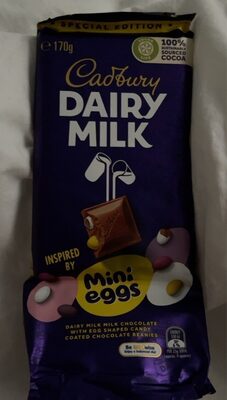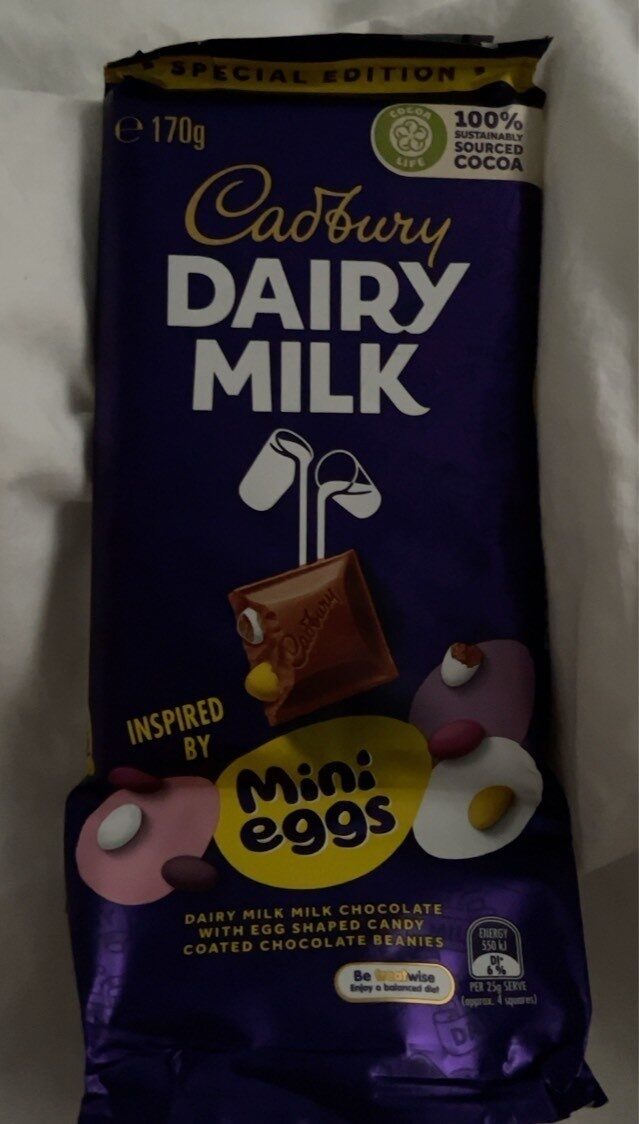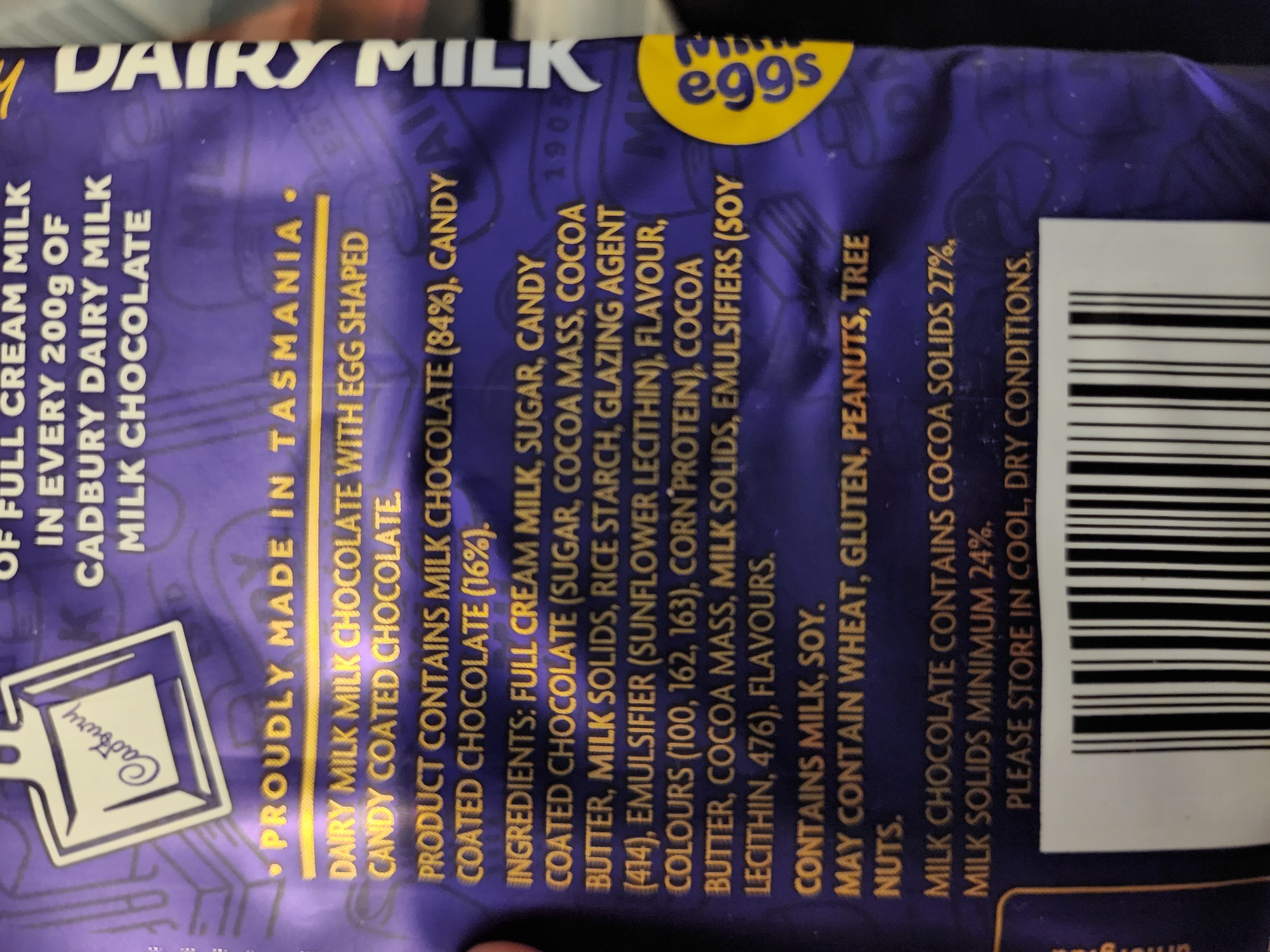Help us make food transparency the norm!
As a non-profit organization, we depend on your donations to continue informing consumers around the world about what they eat.
The food revolution starts with you!
Cadbury Dairy Milk- Mini Eggs
Cadbury Dairy Milk- Mini Eggs
This product page is not complete. You can help to complete it by editing it and adding more data from the photos we have, or by taking more photos using the app for Android or iPhone/iPad. Thank you!
×
Barcode: 9300617298465 (EAN / EAN-13)
Brands: Cadbury
Categories: Snacks, Sweet snacks, Cocoa and its products, Festive foods, Chocolates, Milk chocolates, Easter food, Chocolate eggs, Easter eggs
Stores: Woolworths, Coles
Countries where sold: Australia
Matching with your preferences
Health
Ingredients
-
30 ingredients
full cream milk, sugar, candy coated chocolate (sugar, cocoa mass, cocoa butter, milk solids, rice starch, glazing agent 1905 (414), emulsifier (sunflower lecithin), flavour, m colours (100, 162, 163), corn protein), cocoa butter, cocoa mass, milk solids, emulsifiers (soy lecithin, 476), flavours. contains milk, soy. may contain wheat, gluten, peanuts, tree nuts. milk chocolate contains cocoa solids 27%, milk solids minimum 24%, please store in cool, dry conditions. cadbury 4 dairy milk eggsAllergens: Milk, SoybeansTraces: Gluten, Nuts, Peanuts
Food processing
-
Ultra processed foods
Elements that indicate the product is in the 4 - Ultra processed food and drink products group:
- Additive: E100 - Curcumin
- Additive: E162 - Beetroot red
- Additive: E163 - Anthocyanins
- Additive: E322 - Lecithins
- Additive: E476 - Polyglycerol polyricinoleate
- Ingredient: Emulsifier
- Ingredient: Flavouring
Food products are classified into 4 groups according to their degree of processing:
- Unprocessed or minimally processed foods
- Processed culinary ingredients
- Processed foods
- Ultra processed foods
The determination of the group is based on the category of the product and on the ingredients it contains.
Additives
-
E162 - Beetroot red
Betanin: Betanin, or Beetroot Red, is a red glycosidic food dye obtained from beets; its aglycone, obtained by hydrolyzing away the glucose molecule, is betanidin. As a food additive, its E number is E162. The color of betanin depends on pH; between four and five it is bright bluish-red, becoming blue-violet as the pH increases. Once the pH reaches alkaline levels betanin degrades by hydrolysis, resulting in a yellow-brown color. Betanin is a betalain pigment, together with isobetanin, probetanin, and neobetanin. Other pigments contained in beet are indicaxanthin and vulgaxanthins.Source: Wikipedia
-
E163 - Anthocyanins
Anthocyanin: Anthocyanins -also anthocyans; from Greek: ἄνθος -anthos- "flower" and κυάνεος/κυανοῦς kyaneos/kyanous "dark blue"- are water-soluble vacuolar pigments that, depending on their pH, may appear red, purple, or blue. Food plants rich in anthocyanins include the blueberry, raspberry, black rice, and black soybean, among many others that are red, blue, purple, or black. Some of the colors of autumn leaves are derived from anthocyanins.Anthocyanins belong to a parent class of molecules called flavonoids synthesized via the phenylpropanoid pathway. They occur in all tissues of higher plants, including leaves, stems, roots, flowers, and fruits. Anthocyanins are derived from anthocyanidins by adding sugars. They are odorless and moderately astringent. Although approved to color foods and beverages in the European Union, anthocyanins are not approved for use as a food additive because they have not been verified as safe when used as food or supplement ingredients. There is no conclusive evidence anthocyanins have any effect on human biology or diseases.Source: Wikipedia
-
E322 - Lecithins
Lecithins are natural compounds commonly used in the food industry as emulsifiers and stabilizers.
Extracted from sources like soybeans and eggs, lecithins consist of phospholipids that enhance the mixing of oil and water, ensuring smooth textures in various products like chocolates, dressings, and baked goods.
They do not present any known health risks.
-
E322i - Lecithin
Lecithins are natural compounds commonly used in the food industry as emulsifiers and stabilizers.
Extracted from sources like soybeans and eggs, lecithins consist of phospholipids that enhance the mixing of oil and water, ensuring smooth textures in various products like chocolates, dressings, and baked goods.
They do not present any known health risks.
-
E476 - Polyglycerol polyricinoleate
Polyglycerol polyricinoleate: Polyglycerol polyricinoleate -PGPR-, E476, is an emulsifier made from glycerol and fatty acids -usually from castor bean, but also from soybean oil-. In chocolate, compound chocolate and similar coatings, PGPR is mainly used with another substance like lecithin to reduce viscosity. It is used at low levels -below 0.5%-, and works by decreasing the friction between the solid particles -e.g. cacao, sugar, milk- in molten chocolate, reducing the yield stress so that it flows more easily, approaching the behaviour of a Newtonian fluid. It can also be used as an emulsifier in spreads and in salad dressings, or to improve the texture of baked goods. It is made up of a short chain of glycerol molecules connected by ether bonds, with ricinoleic acid side chains connected by ester bonds. PGPR is a yellowish, viscous liquid, and is strongly lipophilic: it is soluble in fats and oils and insoluble in water and ethanol.Source: Wikipedia
Ingredients analysis
-
Palm oil content unknown
Unrecognized ingredients: Candy-coated-chocolate, Glazing-agent-1905, 414, M-colours, 100, 162, 163, Corn-protein, 476, Milk-chocolate-contains-cocoa-solids, Please-store-in-cool, Dry-conditions, Cadbury-4-dairy-milk-eggsSome ingredients could not be recognized.
We need your help!
You can help us recognize more ingredients and better analyze the list of ingredients for this product and others:
- Edit this product page to correct spelling mistakes in the ingredients list, and/or to remove ingredients in other languages and sentences that are not related to the ingredients.
- Add new entries, synonyms or translations to our multilingual lists of ingredients, ingredient processing methods, and labels.
If you would like to help, join the #ingredients channel on our Slack discussion space and/or learn about ingredients analysis on our wiki. Thank you!
-
Non-vegan
Non-vegan ingredients: Whole milk, Milk solids, Milk solids, Milk solidsSome ingredients could not be recognized.
We need your help!
You can help us recognize more ingredients and better analyze the list of ingredients for this product and others:
- Edit this product page to correct spelling mistakes in the ingredients list, and/or to remove ingredients in other languages and sentences that are not related to the ingredients.
- Add new entries, synonyms or translations to our multilingual lists of ingredients, ingredient processing methods, and labels.
If you would like to help, join the #ingredients channel on our Slack discussion space and/or learn about ingredients analysis on our wiki. Thank you!
-
Vegetarian status unknown
Unrecognized ingredients: Candy-coated-chocolate, Glazing-agent-1905, 414, M-colours, 100, 162, 163, Corn-protein, 476, Milk-chocolate-contains-cocoa-solids, Please-store-in-cool, Dry-conditions, Cadbury-4-dairy-milk-eggsSome ingredients could not be recognized.
We need your help!
You can help us recognize more ingredients and better analyze the list of ingredients for this product and others:
- Edit this product page to correct spelling mistakes in the ingredients list, and/or to remove ingredients in other languages and sentences that are not related to the ingredients.
- Add new entries, synonyms or translations to our multilingual lists of ingredients, ingredient processing methods, and labels.
If you would like to help, join the #ingredients channel on our Slack discussion space and/or learn about ingredients analysis on our wiki. Thank you!
-
Details of the analysis of the ingredients
We need your help!
Some ingredients could not be recognized.
We need your help!
You can help us recognize more ingredients and better analyze the list of ingredients for this product and others:
- Edit this product page to correct spelling mistakes in the ingredients list, and/or to remove ingredients in other languages and sentences that are not related to the ingredients.
- Add new entries, synonyms or translations to our multilingual lists of ingredients, ingredient processing methods, and labels.
If you would like to help, join the #ingredients channel on our Slack discussion space and/or learn about ingredients analysis on our wiki. Thank you!
: full cream milk, sugar, candy coated chocolate (sugar, cocoa mass, cocoa butter, milk solids, rice starch, glazing agent 1905 (414), emulsifier (sunflower lecithin), flavour, m colours (100, 162, 163), corn protein), cocoa butter, cocoa mass, milk solids, emulsifiers (soy lecithin, 476), flavours, milk chocolate contains cocoa solids 27%, milk solids 24%, please store in cool, dry conditions, cadbury 4 dairy milk eggs- full cream milk -> en:whole-milk - vegan: no - vegetarian: yes - ciqual_food_code: 19023
- sugar -> en:sugar - vegan: yes - vegetarian: yes - ciqual_proxy_food_code: 31016
- candy coated chocolate -> en:candy-coated-chocolate
- sugar -> en:sugar - vegan: yes - vegetarian: yes - ciqual_proxy_food_code: 31016
- cocoa mass -> en:cocoa-paste - vegan: yes - vegetarian: yes - ciqual_proxy_food_code: 16030
- cocoa butter -> en:cocoa-butter - vegan: yes - vegetarian: yes - ciqual_food_code: 16030
- milk solids -> en:milk-solids - vegan: no - vegetarian: yes - ciqual_proxy_food_code: 19051
- rice starch -> en:rice-starch - vegan: yes - vegetarian: yes - ciqual_proxy_food_code: 9510
- glazing agent 1905 -> en:glazing-agent-1905
- 414 -> en:414
- emulsifier -> en:emulsifier
- sunflower lecithin -> en:sunflower-lecithin - vegan: yes - vegetarian: yes
- flavour -> en:flavouring - vegan: maybe - vegetarian: maybe
- m colours -> en:m-colours
- 100 -> en:100
- 162 -> en:162
- 163 -> en:163
- corn protein -> en:corn-protein
- cocoa butter -> en:cocoa-butter - vegan: yes - vegetarian: yes - ciqual_food_code: 16030
- cocoa mass -> en:cocoa-paste - vegan: yes - vegetarian: yes - ciqual_proxy_food_code: 16030
- milk solids -> en:milk-solids - vegan: no - vegetarian: yes - ciqual_proxy_food_code: 19051
- emulsifiers -> en:emulsifier
- soy lecithin -> en:soya-lecithin - vegan: yes - vegetarian: yes - ciqual_food_code: 42200
- 476 -> en:476
- flavours -> en:flavouring - vegan: maybe - vegetarian: maybe
- milk chocolate contains cocoa solids -> en:milk-chocolate-contains-cocoa-solids - percent: 27
- milk solids -> en:milk-solids - vegan: no - vegetarian: yes - ciqual_proxy_food_code: 19051 - percent: 24
- please store in cool -> en:please-store-in-cool
- dry conditions -> en:dry-conditions
- cadbury 4 dairy milk eggs -> en:cadbury-4-dairy-milk-eggs
Nutrition
-
Bad nutritional quality
⚠ ️Warning: the amount of fiber is not specified, their possible positive contribution to the grade could not be taken into account.⚠ ️Warning: the amount of fruits, vegetables and nuts is not specified on the label, it was estimated from the list of ingredients: 0This product is not considered a beverage for the calculation of the Nutri-Score.
Positive points: 0
- Proteins: 4 / 5 (value: 6.8, rounded value: 6.8)
- Fiber: 0 / 5 (value: 0, rounded value: 0)
- Fruits, vegetables, nuts, and colza/walnut/olive oils: 0 / 5 (value: 0, rounded value: 0)
Negative points: 36
- Energy: 6 / 10 (value: 2201, rounded value: 2201)
- Sugars: 10 / 10 (value: 58, rounded value: 58)
- Saturated fat: 10 / 10 (value: 17.2, rounded value: 17.2)
- Sodium: 10 / 10 (value: 8800, rounded value: 8800)
The points for proteins are not counted because the negative points are greater or equal to 11.
Nutritional score: (36 - 0)
Nutri-Score:
-
Nutrient levels
-
Fat in high quantity (28.4%)
What you need to know- A high consumption of fat, especially saturated fats, can raise cholesterol, which increases the risk of heart diseases.
Recommendation: Limit the consumption of fat and saturated fat- Choose products with lower fat and saturated fat content.
-
Saturated fat in high quantity (17.2%)
What you need to know- A high consumption of fat, especially saturated fats, can raise cholesterol, which increases the risk of heart diseases.
Recommendation: Limit the consumption of fat and saturated fat- Choose products with lower fat and saturated fat content.
-
Sugars in high quantity (58%)
What you need to know- A high consumption of sugar can cause weight gain and tooth decay. It also augments the risk of type 2 diabetes and cardio-vascular diseases.
Recommendation: Limit the consumption of sugar and sugary drinks- Sugary drinks (such as sodas, fruit beverages, and fruit juices and nectars) should be limited as much as possible (no more than 1 glass a day).
- Choose products with lower sugar content and reduce the consumption of products with added sugars.
-
Salt in high quantity (22%)
What you need to know- A high consumption of salt (or sodium) can cause raised blood pressure, which can increase the risk of heart disease and stroke.
- Many people who have high blood pressure do not know it, as there are often no symptoms.
- Most people consume too much salt (on average 9 to 12 grams per day), around twice the recommended maximum level of intake.
Recommendation: Limit the consumption of salt and salted food- Reduce the quantity of salt used when cooking, and don't salt again at the table.
- Limit the consumption of salty snacks and choose products with lower salt content.
-
-
Nutrition facts
Nutrition facts As sold
for 100 g / 100 mlCompared to: Easter eggs Energy 2,201 kj
(526 kcal)+3% Fat 28.4 g -4% Saturated fat 17.2 g -3% Carbohydrates 59.6 g +5% Sugars 58 g +14% Fiber ? Proteins 6.8 g +34% Salt 22 g +8,460% Fruits‚ vegetables‚ nuts and rapeseed‚ walnut and olive oils (estimate from ingredients list analysis) 0 %
Environment
-
Eco-Score E - Very high environmental impact
⚠ ️The full impact of transportation to your country is currently unknown.The Eco-Score is an experimental score that summarizes the environmental impacts of food products.→ The Eco-Score was initially developped for France and it is being extended to other European countries. The Eco-Score formula is subject to change as it is regularly improved to make it more precise and better suited to each country.Life cycle analysis
-
Average impact of products of the same category: D (Score: 38/100)
Category: Milk chocolate bar
Category: Milk chocolate bar
- PEF environmental score: 0.78 (the lower the score, the lower the impact)
- including impact on climate change: 12.74 kg CO2 eq/kg of product
Stage Impact Agriculture
43.5 %Processing
50.8 %Packaging
1.3 %Transportation
3.7 %Distribution
0.6 %Consumption
0.0 %
Bonuses and maluses
-
Missing origins of ingredients information
Malus:
⚠ ️ The origins of the ingredients of this product are not indicated.
If they are indicated on the packaging, you can modify the product sheet and add them.
If you are the manufacturer of this product, you can send us the information with our free platform for producers.
-
Missing packaging information for this product
Malus: -15
⚠ ️ The information about the packaging of this product is not filled in.⚠ ️ For a more precise calculation of the Eco-Score, you can modify the product page and add them.
If you are the manufacturer of this product, you can send us the information with our free platform for producers.
Eco-Score for this product
-
Impact for this product: E (Score: 18/100)
Product: Cadbury Dairy Milk- Mini Eggs
Life cycle analysis score: 38
Sum of bonuses and maluses: -15
Final score: 18/100
-
Carbon footprint
-
Equal to driving 6.6 km in a petrol car
1274 g CO² per 100g of product
The carbon emission figure comes from ADEME's Agribalyse database, for the category: Milk chocolate bar (Source: ADEME Agribalyse Database)
Stage Impact Agriculture
31.2 %Processing
65.4 %Packaging
0.8 %Transportation
2.4 %Distribution
0.1 %Consumption
0.0 %
Packaging
-
Missing packaging information for this product
⚠ ️ The information about the packaging of this product is not filled in.Take a photo of the recycling information Take a photo of the recycling information
Transportation
-
Origins of ingredients
Missing origins of ingredients information
⚠ ️ The origins of the ingredients of this product are not indicated.
If they are indicated on the packaging, you can modify the product sheet and add them.
If you are the manufacturer of this product, you can send us the information with our free platform for producers.Add the origins of ingredients for this product Add the origins of ingredients for this product
Report a problem
-
Incomplete or incorrect information?
Category, labels, ingredients, allergens, nutritional information, photos etc.
If the information does not match the information on the packaging, please complete or correct it. Open Food Facts is a collaborative database, and every contribution is useful for all.
Data sources
Product added on by kiliweb
Last edit of product page on by inf.
Product page also edited by archanox, moon-rabbit, teolemon, yuka.sY2b0xO6T85zoF3NwEKvlnVmTMGHrmPULEffpUON2uiECcTtY9pU8KXAIas.









